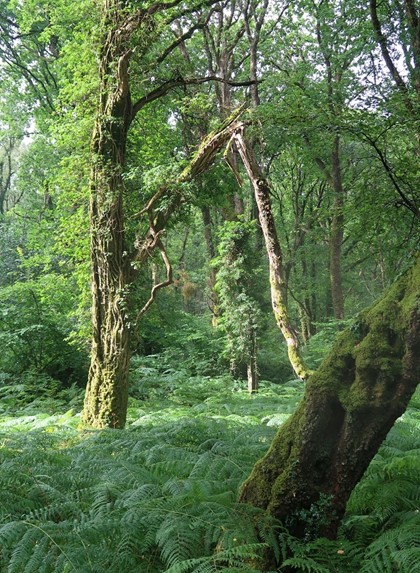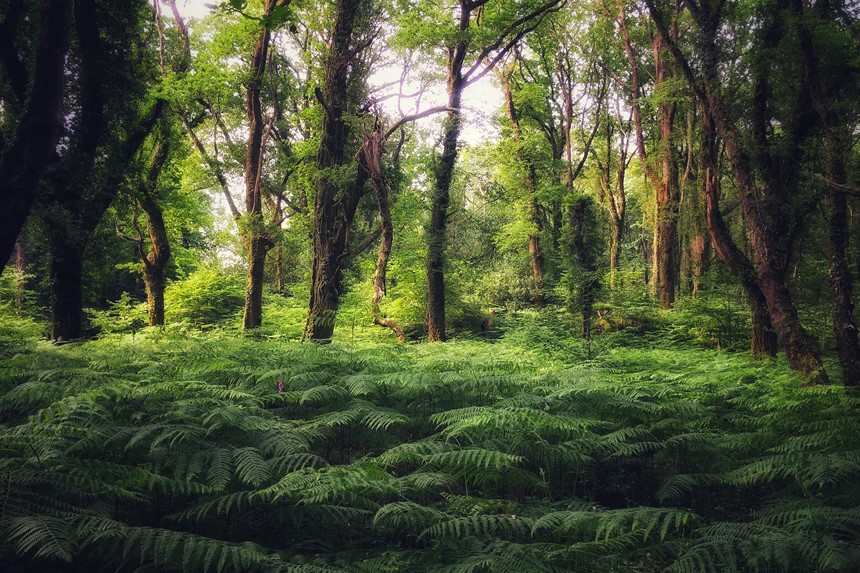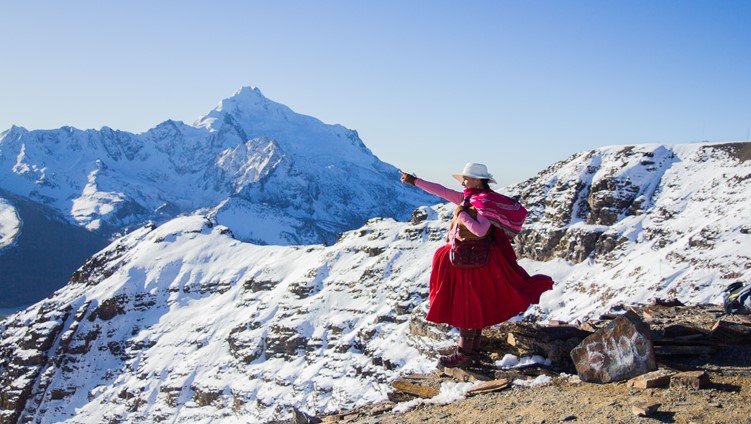Wilderness rites of passage guide Tina Burchill writes about the transitional nature of the wilderness vigil, a four-day-and-night fast alone in the natural world.

Wilderness rites of passage guide Tina Burchill writes about the transitional nature of the wilderness vigil, a four-day-and-night fast alone in the natural world.
As I stepped over the threshold, it began to rain, a misty drizzle that soaked into everything. I had prepared for all eventualities, yet my rucksack was so heavy and weighed down with things hanging off it that I struggled to get the rain cover on.
I was heading out for four days and nights alone on a wooded hillside, and as I wrestled with the rucksack, the metaphor for my own life at that point did not escape me.
This was my first wilderness rite of passage. There was to be no food, no tent, no fire. Our kit list included a tarp to keep the weather off, a bivvy bag, sleeping bag, water of course, and a few other items. I was most concerned about the cold, so was laden down with extra jumpers, two blankets and a heavy sheepskin.
I didn’t know it at the time, but that step into the unknown was to change my life in a myriad of subtle ways that were unimaginable at that moment. I was following in the footsteps of traditional cultures and ancestors, who, for thousands of years, engaged in ritual rites of passage such as wilderness fasts to mark a passage from one stage of life to the next.
As Steven Foster and Meredith Little say in the Book of the Vision Quest: “Without passage rites, individuals could not have understood their life crises, nor could they have been capable of confidently assuming the responsibilities and privileges conferred by their new life station. Tribal units would have become unstable and ceased to survive, for each person’s passage affected the collective.”
Even now, twelve years later, it is difficult to write about, to fully comprehend what exactly happened out there on a hill just outside of Barmouth, North Wales.
Photos courtesy of Tina Burchill


'I didn’t know it at the time, but that step into the unknown was to change my life in a myriad of subtle ways that were unimaginable at that moment. I was following in the footsteps of traditional cultures and ancestors, who, for thousands of years, engaged in ritual rites of passage such as wilderness fasts to mark a passage from one stage of life to the next.'
I spent much of the time staring at the mountain Cadair Idris through the trees, or into the thick mist that often enveloped the valley (Merlin’s breath, as my guide Dr. Martin Shaw described it).
Each day there was a walk to move a rock so that base camp and the person camped nearest to me knew I was OK, but other than that the idea is that you stay in a small area around your ‘camp’. In my case, the rain and the fact that my boots had got soaked on the first day prevented further illicit explorations.
The precise nature of my own experience out there doesn’t gladly lend itself to the written word, to the modern human sphere of understanding. There is no rationality in it, but there isn’t meant to be.
I remember, as if they were old friends, the pattern of the rain on the tarp and the voices of the wind in the trees, and the little brook that ran down the hill just out of sight.
There were times out there, as the long hours turned into days, the rain hardly letting up, that I disappeared into the landscape, a tiny figure poking the puddles off the tarp with a stick to stop the whole precarious shelter from collapsing in on itself.
In the run up to this wilderness quest, as it was called then, I had doubted myself: doubted whether I could manage it, whether I would go the distance, whether the hunger, the cold, the fears, would get the better of me. The truth is that they did – but that’s the point. Collapse is the point. Not a great smiting, but lots of small deaths – a careful dissection of everything that had got me to that place, until it was all broken down.
'Collapse is the point. Not a great smiting, but lots of small deaths – a careful dissection of everything that had got me to that place, until it was all broken down.'
It’s a kind of detox, a processing of a life. Then we get to see the person underneath all of that, so the next chapter can begin. It is as the poet Rainer Maria Rilke says in The Man Watching: we grow by being defeated by constantly greater beings. To be beaten by the Angel, he says, is a strengthening, a kneading into a new shape.
In modern Western culture, we are fixated on overcoming, winning, progressing. But out there, you realise that this stance won’t get you anywhere; you’re supposed to be defeated, to be humble in the face of weather patterns, the comings and goings of animal life, the trees and whatever else might be out there.
That in itself is a challenge to many of us, to submit to something greater than ourselves, to the mysterious and unexplainable. Some might call this God, others the Great Mother, or the Universe.
There is usually no great vision; you don’t walk out with a five-point plan for the rest of your life. It is, as Martin Shaw describes in his book Wolf Milk, actually an ‘unmapping’, a process that happens ‘underneath’.
With more than 25 years of guiding people through this process under his belt, he says: “I’ve seen again and again that what can return is too complex an experience to be prematurely tied up with a bow. The disclosures are often subtle. More of a stumbling conversation, a broken croak rather than a eureka moment.”
This is one of the reasons he removed the word ‘quest’ from the process nine years ago, when the School of Myth began offering this rite of passage on Dartmoor. Until then this process was more usually called a vision quest, a template based on a Native American model made popular by the work of Stephen Foster and Meredith Little at the School of Lost Borders in the USA.
Traditionally, these four-day fasts would have been undertaken by teenagers to mark the transition to adulthood, but these days, in the West, it is largely older people who turn up at our base camp.
Backgrounds are wide and varied, but there is one thing they all have in common: they are at a crossroads in their lives, seeking guidance on navigating the next steps. They want to know what is next and how to get there.
'In modern Western culture, we are fixated on overcoming, winning, progressing. But out there, you realise that this stance won’t get you anywhere; you’re supposed to be defeated, to be humble in the face of weather patterns, the comings and goings of animal life, the trees and whatever else might be out there.'
When I applied to undertake this process, I had completed Martin’s five-weekend programme with his little hedge school (a small affair back then, but these days attracting 60 people from all over the globe), and was helping out as part of the crew.
The call came as an invitation entitled ‘The King and Queen must wed the land’, referring to an old Arthurian idea that in order to have sovereignty, a grounded relationship to the living earth is essential. I didn’t want to do it, I had to do it. It felt like something deep inside me had been activated, as if some ancestral memory had been awoken.
Indeed, the Celtic stories of King Arthur and the Round Table are an example of a mythology that likely contains threads of the old ways. Philosopher and historian of religion Mircea Eliade, writing in the 1960s, explains this idea. He says these tales, although written down in poem form in the 12th century, originate in much older Celtic and Irish mythology, postulating that they hold remnants of ancient rites of passage actually performed. We see quests for objects, heroes entering the other world – and in the completion of tasks, a wound is cured, a sovereign is healed, and the ailing land is regenerated.
Whatever their origins, the fact that these stories are still with us today indicates that they speak to something deep in our imagination, or what the Jungians call the collective unconscious.
As anthropologist and deep ecologist Joan Halifax says in her book The Fruitful Darkness: “... stories are threads that draw one back into the fabric of the Earth. Bright fibres that join worlds, stories illumine our deep past and our origins, our ancestors and the ancestors of all creation … they also draw us through the eye of the future.”
It is unsurprising, then, that this idea resonated so deeply.
Photo courtesy of Nicola Smalley

But there was something else that got me out there. In this time of climate change, of looming environmental disaster, I reasoned that the very least I could do in a world where human beings take so much was to give up food and comfort for four days, and to ask the question of how I could help.
This concept of service is a central facet of the wilderness vigil. Too often these days nature is seen as merely the backdrop to our own ‘healing’. Fundamental questions all vigilers will be asking is what in themselves has come to die out there, and how they can be of service. We see it as a dialogue with the natural world, not a human monologue.
Martin Shaw’s approach to the wilderness vigil is also, of course, a mythological one. For most of human history we have been an oral culture, understanding the world through the images and metaphor of stories. The earth, he says, ‘speaks in myth’.
So out there on the hillside, I stepped out of the modern world for a while. Clearing the puddles from my tarp, I was the boy in Iron John who emptied a lake with a bucket; when I got lost in the woods, I was Vasilisa who met the Russian witch Baba Yaga and lived to tell the tale.
After three days of fasting and mental processing, I was finally empty, and porous. At some point my psyche drifted out into the landscape, into the anima mundi, perhaps a bit like the biological process of diffusion, and for a brief time rubbed up against a much larger psyche, or soul.
'This concept of service is a central facet of the wilderness vigil. Too often these days nature is seen as merely the backdrop to our own ‘healing’. Fundamental questions all vigilers will be asking is what in themselves has come to die out there, and how they can be of service. We see it as a dialogue with the natural world, not a human monologue.'
It was a few years later that the opportunity came to train with Martin to become a guide myself, to lead others through this process in a private wooded valley on Dartmoor. I knew this was the ‘service’ being asked of me. Nine years on, I have seen more than 100 people through the wilderness vigil, and witnessed as many different stories of transition.
The idea that I would be doing this work was unimaginable as I drove out of Barmouth twelve years ago. But as I travelled along a dual carriageway out of town, a buzzard flew alongside the car for a few minutes. I knew then that the woman with the overburdened rucksack was not the woman who had stepped back into the world. I had come back a slightly different shape.
References

